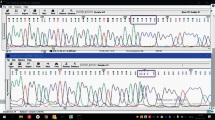Abstract
IN humans, long-wavelength-sensitive and middle-wavelength-sensitive cone pigments are encoded by genes lying in a head-to-tail tandem array on the X chromosome. Deficiencies in red–green colour vision seem to arise from unequal recombination of these normal X-linked genes1,2. In some dichromats this recombination is believed to yield a fusion gene encoding a product with an absorption spectrum similar to that of one or the other of the normal photopigments2. Until now, however, such a relationship between the structure of a pigment gene and the spectral properties of its encoded pigment has not been directly shown. We have now sequenced a fusion gene isolated from a red-green colour-blind human and determined the spectral properties of the pigment that it encodes. The absorption spectrum of the photopigment was very similar to that of normal middle-wavelength-sensitive photopigment, even though about half of its DNA coding sequence seems to be derived from a gene encoding normal long-wavelength-sensitive pigment. These results indicate the regions of the X-encoded photopigment apoproteins that are responsible for differences in their spectral tuning, and imply that the striking variations in colour vision among anomalous trichromats of a particular type are not attributable to anomalous pigments with differing spectral peaks.
Similar content being viewed by others
References
Nathans, J., Thomas, D. & Hogness, D. S. Science 232, 193–202 (1986).
Nathans, J., Piantanida, T. P., Eddy, R. L., Shows, T. B. & Hogness, D. S. Science 232, 203–210 (1986).
Nagy, A. L. J. opt. Soc. Amer. 72, 571–577 (1982).
Pokorny, J. & Smith, V. C. Color Res. Appl. 7, 159–164 (1982).
Neitz, J. & Jacobs, G. H. J. opt. Soc. Amer. A1, 1175–1180 (1984).
Schnapf, J. L., Kraft, T. W. & Baylor, D. A. Nature 325, 439–441 (1987).
Lehninger, A. L. Biochemistry (Worth, New York, 1975).
Hackett, N. R., Stern, L. J., Chao, B. H., Kronis, K. A. & Khorana, H. G. J. biol. Chem. 262, 9277–9284 (1987).
Kosower, E. M. Proc. natn. Acad. Sci. U.S.A. 85, 1076–1080 (1988).
Drummond-Borg, M., Deeb, S. & Motulsky, A. G. Am. J. hum. Genet. 43, 675–683 (1988).
Hurvich, L. M. & Jameson, D. Mod. Probl. Opthalmol. 13, 200–209 (1974).
Wyszecki, G. & Stiles, W. S. Color Science (Wiley, New York, 1982).
Dawis, S. M. Vision Res. 21, 1427–1430 (1981).
DiLella, A. G. & Woo, S. L. C. Meth. Enzym. 152, 199–212 (1987).
Wahl, G. M. et al. Proc. natn. Acad. Sci. U.S.A. 84, 2160–2164 (1987).
Sanger, F., Nicklen, S. & Coulson, A. R. Proc. natn. Acad. Sci. U.S.A. 74, 5463–5467 (1977).
Author information
Authors and Affiliations
Rights and permissions
About this article
Cite this article
Neitz, J., Neitz, M. & Jacobs, G. Analysis of fusion gene and encoded photopigment of colour-blind humans. Nature 342, 679–682 (1989). https://doi.org/10.1038/342679a0
Received:
Accepted:
Issue Date:
DOI: https://doi.org/10.1038/342679a0
- Springer Nature Limited
This article is cited by
-
Trichromatic color vision with only two spectrally distinct photopigments
Nature Neuroscience (1999)
-
Molecular genetics of human color vision
Behavior Genetics (1996)





